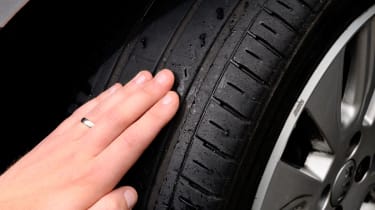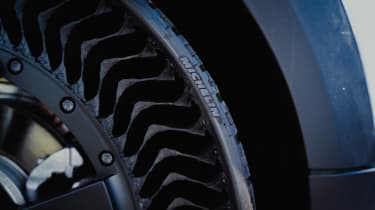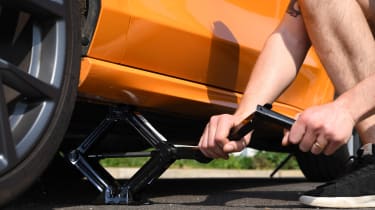While tyres have come a long way since the dawn of the motoring era, their basic concept has remained the same – a rubber air-filled (or more recently nitrogen-filled) donut. Traditional high pressure pneumatic tyres are used to support the car, absorb bumps and provide the traction and grip needed to drive it safely. Airless tyres, also known as non-pneumatic tyres or flat-free tyres, however, are a revolutionary new design that does away with the need to keep tyres inflated with air.
Airless tyres are not to be confused with run-flat tyres. These are air-filled tyres specifically designed with extra sidewall strengthening that makes them capable of driving for around 50 miles at a maximum speed of 50mph even when deflated after a puncture. Airless ‘flat-free’ tyres are so-called as they are never filled with air and can therefore never suffer a puncture in the first place.
While the use of airless tyres is already a reality on small vehicles such as motorised golf carts or equipment like ride-on lawnmowers, their testing and application on large passenger vehicles is a more recent development.
Most airless tyre designs use strong interlaced spokes or mesh-like structures that surround the wheel and can flex and change shape as the car drives and goes over bumps. There’s still much development and plenty of testing to be carried out before airless tyres become available to consumers on a large scale, but reports suggest that Michelin could debut its Uptis (Unique Puncture-proof Tire System), made with a high-strength resin embedded with fibreglass, as early as 2024. Uptis tyres will reportedly be made available in the East Asian market to begin with, where poor road surfaces make their durability a major advantage.
What are the advantages of airless tyres?
No flat tyres
The most immediate benefit to an airless tyre is that it does away with the risk of a puncture which can leave your car limping or even stranded by the side of the road while you change the wheel, dig out the puncture repair kit or wait for help.
You’re less likely to experience issues with airless tyres that can’t be punctured – Goodyear’s rigorous testing of airless tyres reveals that although it’s possible for spokes to deform and break, they can continue to perform safely afterwards.
No need for spare tyres
Given that drivers will be much less likely to encounter a problem with their tyres, there’ll be less of a need for a spare, or a puncture repair kit in cars. In recent times it’s become much less common for cars to come with full-size spare tyres anyway. Many only come with space savers that can’t be used for extended periods or have a tube of puncture repair goo and an electric tyre inflator. Airless tyres do away with the need for this equipment altogether, leaving more storage space in the boot for luggage.
Airless tyres could help businesses save money
Massive disruption can be caused to important industries such as agriculture, mining and construction if the vehicles they heavily rely on suffer tyre failure. The same can be said for those in the taxi industry or public transport – a cab or a bus with a puncture is a loss to someone’s livelihood and a potential obstruction for other drivers. With the eradication of flat tyres these industries can remain productive and efficient, keeping costs down.
Airless tyres last longer and require less maintenance than conventional tyres

It’s been suggested that airless tyres could also last up to three times as long as conventional tyres, which means they’ll need to be replaced far less frequently. Tyre pressures don’t need to be tweaked, which means that the tyres are always running in the optimum state for fuel economy and protection from excessive wear.
Michelin’s ‘Tweel’ (a combination of the words ‘tyre’ and ‘wheel’) has been around since 2005 and has so far been used successfully on light, slow-moving vehicles used in agriculture and construction.
Potential for less CO2 emissions
Tyres experience what’s known as rolling resistance. Energy is lost when a tyre flexes on contact with the road’s surface, making it harder to roll and requiring more force from the car’s engine to move. Some manufacturers, such as Bridgestone, argue that the rolling resistance in their concept air-free tyres is just as low as that of their inflated fuel efficient ‘Ecopia’ tyres, making them more efficient than the average mainstream tyre.
Airless tyres can be easily recycled
Many tyre companies claim that their airless tyre designs are made from completely recycled materials and can go on to be recycled in future to create new airless tyres. Bridgestone calls this its ‘cradle-to-cradle’ system, and its non-pneumatic tyres will be the first of all types of tyre to make this a reality.
What are the disadvantages of airless tyres?

Airless tyres are noisy
One of the limitations of airless tyres is that they’re currently much noisier than conventional air-filled ones. Airless tyres also pass more vibration through the vehicle than traditional tyres, although the technology is progressing to improve this. For now, though, drivers used to the response and feel of regular tyres could find airless tyres hard to get used to.
Airless tyres are expensive to buy
For now, at least, airless tyres are on the expensive side. The Michelin Tweel costs up to $750 per wheel (Around £630 in the UK) depending on the size and type but that is for a tyre and wheel combination. These are also limited to a top speed of just 38mph and only available for use on small UTV-style commercial vehicles.
If and when larger airless tyres become available on everyday passenger vehicles, they’re also likely to be relatively expensive initially. If they catch on and become more widespread, though, the high costs could eventually come down.
Not all airless tyres reduce CO2 emissions
While Bridgestone claims cars fitted with its airless tyres could produce less CO2 emissions compared to cars fitted with average tyres, not everyone agrees. Some claim that most airless tyres have, in fact, a larger contact patch (the area of the tyre that makes contact with the road’s surface) and therefore have a higher rolling resistance. This can make a car’s engine less efficient as it has to use more energy and fuel to get the wheels moving, which also increases CO2 emissions. For electric cars, this means battery life and range could be negatively affected.
Clearly the design of each individual type of airless tyre has a significant impact on its rolling resistance, so manufacturers will be aiming to develop airless tyres that bring advantages in terms of fuel economy and emissions.
While airless tyres aren’t available just yet, check out our list of the best tyres to buy now…

